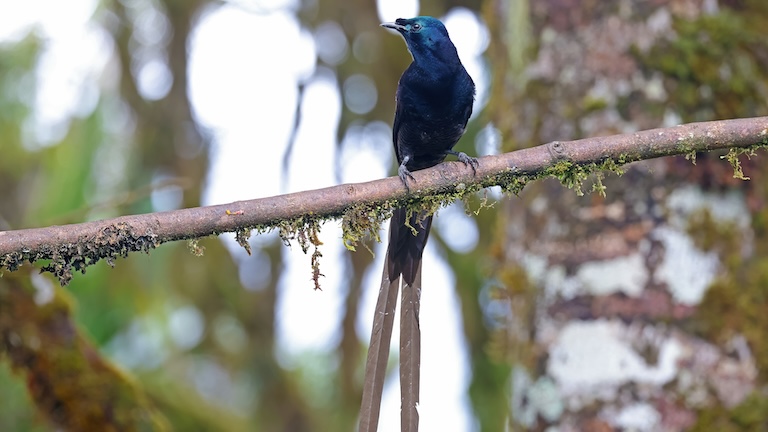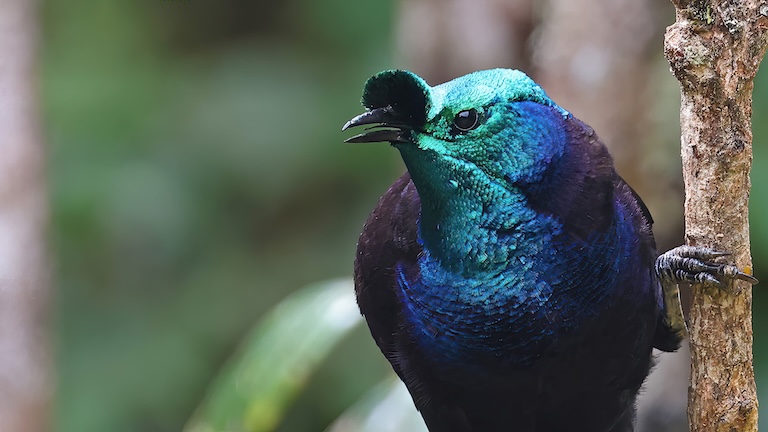Ribbon-Tailed Astrapia Profile
Birds of Paradise are an exceptionally varied family of passerine birds from the New Guinea area, known for their exaggerated sexual dimorphism and tendency to perform intricate mating rituals.
It’s long been thought that some of the frills, bells and whistles that the males have use to present as tempting offers to the females are in competition with one another, and that resources put into one reduce the effectiveness of the others.
But recent research has suggested there might be more to it that this, and the so-called ‘courtship phenotype’ is a robust amalgam of visual and acoustic cues that work together as a complimentary set of courtship behaviours.
The ribbon-tailed astrapia is the most recently discovered Bird of Paradise, and while all the above may apply to it, it’s mostly appreciated for having a really, really long tail.

Ribbon-Tailed Astrapia Facts Overview
| Habitat: | Upper-montane Forest |
| Location: | New Guinea |
| Lifespan: | Unknown |
| Size: | 32 cm (1 ft) long, males can have a tail of over 1m (3.2 ft) long |
| Weight: | Unknown, estimated 100g |
| Colour: | Dark, olive green and bronze, iridescent plumage with blue neck |
| Diet: | Omnivorous, mostly fruit, some insects, spiders, frogs |
| Predators: | Few: some snakes, raptors |
| Top Speed: | Unknown |
| No. of Species: | 1 |
| Conservation Status: | Least Concern (IUCN) |
These little birds are packed with sensory impressions. While related to crows, they have a far more pleasant song, and their plumage is, like so many of their family, stunning.
The female Ribbon-tailed has iridescence on the head and the male’s tail is white rather than black, but both birds are very pretty, and even the chicks are passable.
The male’s tail is its crowning achievement and can be up to a meter long, and they use it to court females.
As with most species, they are losing habitat, but for now, the species is still relatively abundant.
Interesting Ribbon-Tailed Astrapia Facts
1. They’re related to crows
The Superfamily Corvoidea contains the corvids, like your ravens and crows, and also your shrikes and drongos, and other crow-like relatives.
This is the family in which the birds of paradise are situated and to be quite honest, they put the others to shame.

They range from 50g up to half a kilo, and the Ribbon-tailed astrapia is somewhere at the lower end of this spectrum likely at around 100 g.
They have a lot more variation than other families in this group, not only by how they look but by the range of sounds and motions they are capable of.
Much of these impressive feats come from the male’s side, as a way of snagging a mate.
2. Sexual dimorphism in birds is common
Sexual dimorphism refers to the difference in size and shape between animals of opposite sex. Female humans have a fantastic pair of morphological differences on their upper bodies, for example, and are generally a bit smaller compared with male humans, but they’re mostly the same shape and colour, varying by around 15% in size on average.
Birds are usually a lot more extreme in their dimorphism. In any heterosexual bird couple, if there’s one pretty one and one plain one, the pretty one is going to be the male.
And this is all a part of sexual selection in birds; the males are trying to show off how fit they are by presenting the females with a bunch of expensive accessories. Bright pigments, longer feathers, and intricate serenades all suggest the male has had a lot of time and good health to spend on looking great.
And this means they’re probably quite healthy, as a bird with bad genes probably doesn’t have a lot of time and energy to spare dolling themselves up. This is common across the animal kingdom, but rarely do you see it taken so far as you do with birds of paradise.
3. Ribbon-Tailed Astrapia take it to the extreme
The male ribbon-tailed astrapia has smooth, velvety plumage that is jet black, in contrast with its green iridescent patches of olive-green.
But what sticks out the most is the tail itself. The feathers emanating from this little bird’s butt can be a meter long, and are 2cm across. They hang down like two white ribbons, contrasting firmly against the body of the bird and really showing off excess to potential mates.
These are the longest tail feathers in relation to body size of any bird and are over three times the length of its body. 1

4. It works
Female atrapias love a good bit of tail, and a successful male will mate with several of them each year. Since he’s put so much work into his looks, it’s up to her to build the nest and rear the young, and his duties are more aligned with that of a trophy husband.
But to get to a female, he must perform an entire courtship display in competition with multiple other males, which involved jumping between branches and trying not to trip over the tail.
These groups of males are called Leks, and they’re common across the animal kingdom. 2 3
5. Logging is a problem
This species is locally threatened by hunting, since the tail feathers are popular among the local humans, too. However large-scale logging and deforestation are some of the major threats to these birds.
As of now, however, the ribbon-tailed astrapia is doing okay and is of least concern, but their numbers are declining.
Ribbon-Tailed Astrapia Fact-File Summary
Scientific Classification
| Kingdom: | Animalia |
| Phylum: | Chordata |
| Class: | Aves |
| Order: | Passeriformes |
| Family: | Paradisaeidae |
| Genus: | Astrapia |
| Species: | Mayeri |
Fact Sources & References
- “Ribbon-tailed Astrapia”, Oiseaux Birds.
- Edwin Scholes (2017), “Visual and acoustic components of courtship in the bird-of-paradise genus Astrapia (Aves: Paradisaeidae)”, Peer J.
- CB Frith (1993), “The Nesting Biology of the Ribbon-tailed Astrapia Astrapia mayeri (Paradisaeidae)”, CSIRO PUBLISHING.
